Related Research Articles
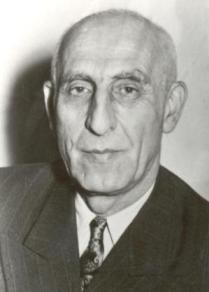
Mohammad Mosaddegh was an Iranian politician, author, and lawyer who served as the 35th Prime Minister of Iran from 1951 to 1953, after appointment by the 16th Majlis. He was a member of the Iranian parliament from 1923, and served through a contentious 1952 election into the 17th Iranian Majlis, until his government was overthrown in the 1953 Iranian coup d'état orchestrated by the intelligence agencies of the United Kingdom (MI6) and the United States (CIA), led by Kermit Roosevelt Jr. His National Front was suppressed from the 1954 election.

The Islamic Consultative Assembly, also called the Iranian Parliament, the Iranian Majles, is the national legislative body of Iran. The Parliament currently consists of 290 representatives, an increase from the previous 272 seats since the 18 February 2000 election. The most recent election took place on 21 February 2020 and the new parliament convened on 28 May 2020.

The 1953 Iranian coup d'état, known in Iran as the 28 Mordad coup d'état, was the overthrow of the democratically elected Prime Minister Mohammad Mosaddegh in favor of strengthening the monarchical rule of the Shah, Mohammad Reza Pahlavi on 19 August 1953. It was orchestrated by the United States and the United Kingdom. The clergy also played a considerable role.
The Tudeh Party of Iran is an Iranian communist party. Formed in 1941, with Soleiman Mirza Eskandari as its head, it had considerable influence in its early years and played an important role during Mohammad Mosaddegh's campaign to nationalize the Anglo-Persian Oil Company and his term as prime minister. The crackdown that followed the 1953 coup against Mosaddegh is said to have "destroyed" the party, although a remnant persisted. The party still exists but has remained much weaker as a result of its banning in Iran and mass arrests by the Islamic Republic in 1982, as well as the executions of political prisoners in 1988.
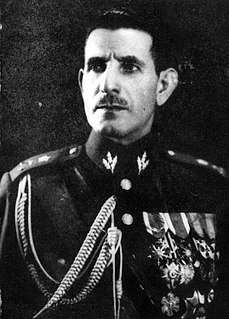
Ali Razmara, also known as Haj Ali Razmara, was a military leader and prime minister of Iran.

Sayyid Mojtaba Mir-Lohi, more commonly known as Navvab Safavi, was an Iranian Shia cleric and founder of the Fada'iyan-e Islam group. He played a role in assassinations of Abdolhossein Hazhir, Haj Ali Razmara and Ahmad Kasravi. On 22 November 1955, after an unsuccessful attempt to assassinate Hosein Ala', Navvab Safavi and some of his followers were arrested. In January 1956, Safavi and three other members of Fada'iyan-e Islam were sentenced to death and executed.

Hasan Ali Mansur was an Iranian politician who served as Prime Minister from 1964 to 1965. He served during the White Revolution of the Shah Mohammad Reza Pahlavi and was assassinated by a member of the Fada'iyan-e Islam.
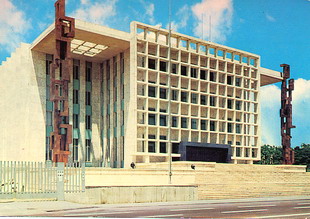
The Senate was the upper house legislative chamber in Imperial State of Iran from 1949 to 1979. A bicameral legislature had been established in the 1906 Persian Constitutional Revolution but the Senate was not actually formed until after the Iran Constituent Assembly, 1949, as an expression of Shah Mohammad Reza Pahlavi's desire for more political power. The Senate was filled mainly with men who were supportive of the Shah's aims, as intended by the Shah. Half of the sixty seats in the senate were directly appointed by the Shah, fifteen represented Tehran, and the rest were elected from other regions.
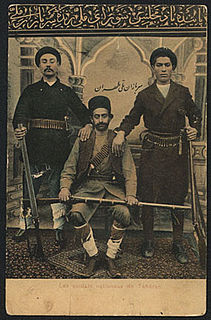
The Persian Constitution of 1906, was the first constitution of the Sublime State of Persia, resulting from the Persian Constitutional Revolution and it was written by Hassan Pirnia, Hossein Pirnia, and Ismail Mumtaz, among others. It divides into five chapters with many articles that developed over several years. The Quran was the foundation of this constitution while Belgian constitution served as a partial model for the document.

Fadā'iyān-e Islam is a Shia fundamentalist group in Iran with a strong activist political orientation. The group was founded in 1946, and registered as a political party in 1989.

Answer to History is a memoir written by the last Shah of Iran, Mohammad Reza Pahlavi, shortly after his overthrow in 1979 by Islamic revolution. The book was originally written in French and was translated into English and Persian as well as other languages, and was published posthumously in 1980.

The Persian Constitutional Revolution, also known as the Constitutional Revolution of Iran, took place between 1905 and 1911. The revolution led to the establishment of a parliament in Persia (Iran) during the Qajar dynasty.
A constitutional referendum was held in Iran on 2 and 3 December 1979. The new Islamic constitution was approved by 99.5% of voters.
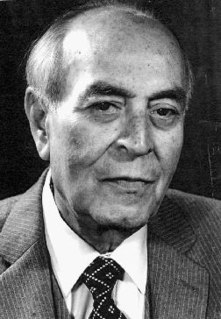
Iraj Eskandari was an Iranian communist politician. A Qajar prince, Eskandari received French education. He was the first general secretary of the Tudeh Party of Iran and a member of parliament. In the summer of 1946 he was named a Minister of Commerce and Industry in Qavam's coalition cabinet.
The Comrades Party or the Compatriots Party was a left-wing Iranian political party active during the 1940s.

Parliamentary elections were held in Iran in 1950.
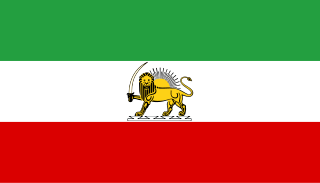
The Imperial State of Iran was the official name of Iran under rule of the Pahlavi dynasty.

Abbas Eskandari was an Iranian Communist politician and a co-founder of Tudeh Party of Iran.
Anarchism in Iran has its roots in a number of dissident religious philosophies, as well as in the development of anti-authoritarian poetry throughout the rule of various imperial dynasties over the country. In the modern era, anarchism came to Iran during the late 19th century and rose to prominence in the wake of the Constitutional Revolution, with anarchists becoming leading members of the Jungle Movement that established the Persian Socialist Soviet Republic in Gilan.
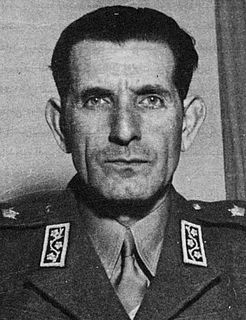
The cabinet led by Haj Ali Razmara was formed on 26 June 1950 and succeeded the cabinet of Ali Mansur who was in office between April and June 1950. Razmara was a lieutenant general at the imperial army and was serving as the chief of the general staff when he was appointed by the Shah Mohammad Reza Pahlavi as the prime minister. It was the 33rd and first military cabinet in Iran since 1924. Behrooz Moazami also argues that it was one of the cabinets which did not follow the political agenda of the Shah in addition to the cabinets of Mohammad Mosaddegh and those of Ahmad Qavam in the Pahlavi rule.
References
- ↑ Elm, Mostafa (1994). Oil, Power, and Principle: Iran's Oil Nationalization and Its Aftermath. Syracuse University Press. p. 57. ISBN 0815626428.
- ↑ Sohrabi, Nader (2011). Revolution and Constitutionalism in the Ottoman Empire and Iran. Cambridge University Press. p. 355. ISBN 978-0521198295.
- ↑ Alem, Yasmin. Duality by Design: The Iranian Electoral System. IFES. p. 9. ISBN 1931459592.
- ↑ "Iran (1905–present)". Political Science. University of Central Arkansas. Retrieved 13 August 2012.
- ↑ Afary, Janet (1996). The Iranian Constitutional Revolution, 1906–1911: Grassroots Democracy, Social Democracy, & the Origins of Feminism . Columbia University Press. p. 66. ISBN 0231103514.
- ↑ Afary 1996, pp. 84–86
- ↑ Binder, Leonard (1962). Iran: Political Development in a Changing Society (2 ed.). University of California Press. p. 284.
- ↑ Farsoun, Samih K. (1992). Iran: Political Culture in the Islamic Republic. Psychology Press. pp. 93–95. ISBN 0415031427.
- ↑ Milani, Abbas (2012). The Shah. Macmillan. p. 136. ISBN 978-0230340381.
- ↑ Gasiorowski, Mark J.; Byrne, Malcolm (2004). Mohammad Mosaddeq and the 1953 Coup in Iran. Syracuse University Press. p. 28. ISBN 0815630182.
- 1 2 Blake, Kristen R. (2004). US-Soviet Confrontation in Iran, 1945–1962. University Press of America. p. 49. ISBN 0761844910.
- 1 2 Abrahamian, Ervand (1982). Iran Between Two Revolutions . Princeton University Press. pp. 249–250. ISBN 0691101345.
- 1 2 3 Blake 2004, p. 50
- 1 2 Milani 2012, pp. 131–133
- ↑ Arjomand, Said Amir (1984). From Nationalism to Revolutionary Islam. SUNY Press. pp. 162–163. ISBN 0873958705.
- ↑ Hiro, Dilip (2005). The Iranian Labyrinth: Journeys Through Theocratic Iran and Its Furies. Nation Books. p. 96. ISBN 1560257164.
- ↑ Milani 2012, pp. 133–134
- 1 2 Daniel, Elton L. (2001). The History of Iran. Greenwood Publishing. p. 148. ISBN 0313307318.
- 1 2 Kingston, Paul W. (2002). Britain and the Politics of Modernization in the Middle East, 1945–1958. Cambridge Middle East Studies. Vol. 4. Cambridge University Press. pp. 79–83. ISBN 0521894395.
- ↑ Afkhami, Gholam Reza (2008). The Life and Times of the Shah. University of California Press. p. 205. ISBN 978-0520253285.
- ↑ Mackey, Sandra (1998). The Iranians: Persia, Islam and the Soul of a Nation. Plume. p. 197. ISBN 0452275636.
- ↑ Farsoun 1992, pp. 40–41
- ↑ Riesebrodt, Martin (1998). Pious Passion: The Emergence of Modern Fundamentalism in the United States and Iran. Comparative Studies in Religion and Society. Vol. 6. University of California Press. pp. 114–115. ISBN 0520074645.
- ↑ Chehabi, Houchang (2006). Distant Relations: Iran and Lebanon in the Last 500 Years. I.B.Tauris. p. 141. ISBN 1860645615.
- 1 2 Afkhami 2008, [p. 117 https://books.google.com/books?id=pTVSPmyvtkAC&pg=PA117]
- 1 2 3 Azimi, Fakhreddin (2008). Quest for Democracy in Iran: A Century of Struggle Against Authoritarian Rule. Harvard University Press. p. 139. ISBN 978-0674027787.
- 1 2 Milani 2012, p. 137
- ↑ Afkhami 2008, p. 99
- ↑ Ladjevardi, Habib (1985). Labor Unions and Autocracy in Iran. Syracuse University Press. p. 259. ISBN 0815623437.
- ↑ Ladjevardi 1985, p. 263
- ↑ "The Tudeh Party: Vehicle of Communism in Iran". Central Intelligence Agency. 18 July 1949. p. 5. Archived from the original on 2012-08-07. Retrieved 16 August 2012.
- ↑ Sanghvi, Ramesh (1968). Aryamehr: the Shah of Iran: a political biography (2 ed.). Macmillan. pp. 165–166.
- ↑ Spencer, William (1962). Political evolution in the Middle East . Lippincott. p. 137.
- ↑ Nohlen, Dieter; Grotz, Florian; Hartmann, Christof (2001). Elections in Asia and the Pacific: a data handbook. Vol. 1. Oxford University Press. pp. 51, 72. ISBN 019924958X.